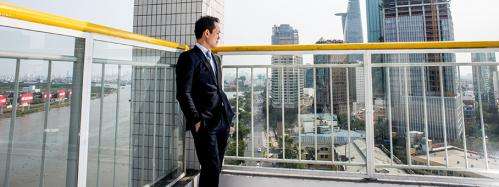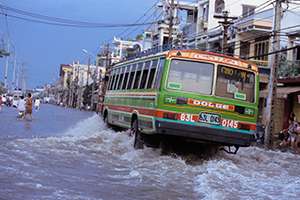Ho Chi Minh City facing massive infrastructure challenges

Thai Lai Pham was three years old when the Vietnam War ended in 1975. He still remembers the postwar years very well—hunger and poverty, the oil lamp he used to read by because there was no electricity, and getting up at 3 a.m. with his parents to go get fresh water. He also remembers occasional strenuous trips from his hometown, Hue—the former capital of the empire, located in the middle of Vietnam—to Saigon, which today is called Ho Chi Minh City. It was a distance of 1,000 kilometers, and the trip took three days and two nights.
Dr. Lai, as his coworkers at Siemens respectfully call him, is standing at a window in his office in Ho Chi Minh City and looking at the gigantic stretch of wasteland on the other side of the Saigon River. Here, the city government has torn down old houses in order to build a new financial district. Much has changed in the city in addition to its name. Electric light and running water have become a normal part of life for its inhabitants. The economic reform policy known as "Doi Moi" (New Life) has decreased the poverty rate from 70 percent before the launch of the program in 1986 to ten percent today.
Many of the old problems have disappeared, but new ones have arisen. One of them is chaotic traffic. About 4.5 million mopeds clog the streets and create massive air pollution. Fortunately, there are only about half a million cars in the city. If those figures were reversed, the transportation network would break down completely. There is still no rail-based public transportation, such as a subway system, either in Ho Chi Minh City or in the rest of the country—even though Saigon had a steam-operated streetcar system as early as 1881 and an electric streetcar system in 1923. And the bus fleet in Ho Chi Minh City is hopelessly overcrowded.
"It's incredible how quickly everything here is changing," Pham thinks every time he drives his car home from work. If you've been away for just two weeks, on your way home from the airport you're sure to see new shells being built for the ever-popular high-rise apartment buildings. The culture shock was especially great for Pham, who is now 42, when he returned to Vietnam two years ago. He had emigrated to Germany with his parents when he was ten years old.

Pham studied electrical engineering in Munich and received his M.A. and Ph.D. degrees in Princeton, New Jersey while working at Siemens Corporate Technology's research center there. He subsequently worked at a business consulting company and then at Siemens in the areas of IT, corporate strategy, medical technology, and gas turbines. At that point Siemens was looking for a new country director for Vietnam, and Pham turned out to be the right man for the job. He has been familiar with the country, the people, and the language since his childhood. Nonetheless, it wasn't easy for him, his wife, and his two children to adjust to the country once they got there. "Life in Vietnam has completely changed," he says. "Of course this also has its positive side. Above all, the infrastructure in Vietnam has improved considerably."
All the same, the infrastructure is still far from being good enough. Together with the Society for International Cooperation and the People's Committee of Ho Chi Minh City, Siemens published a study called "Ho Chi Minh City 21," which sums up the city's challenges. One of them is rapid urbanization. The city's population is growing by about 200,000 people annually. In 2013, about 33 percent of Vietnamese lived in cities, but by 2050 that figure is expected to be 60 percent. Another challenge is the increase of traffic despite the lack of an adequate public transportation network. There's also the city's precarious geographic situation. Almost half of its area lies less than one meter above sea level and is at risk of flooding, partly because of climate change. New satellite towns are continually being created in swampy areas. The study concludes that the city must invest considerable amounts in new infrastructure. In addition to flood prevention and an improved water distribution system, it needs an extensive subway system and an active traffic management program.
Diplomacy Required. An initial subway line is being built, and a second stretch is being planned. A master plan for public transportation calls for the construction of a total of seven lines. Siemens has been advising the city for a decade now on the Line 2 project. The call for tenders will probably be issued in 2014. Such plans cannot be realized without expertise from abroad. As a result, the 300 Siemens employees who are working under Pham's leadership in Vietnam are valued as contact partners for major infrastructure projects. Pham, who is not only the country manager but also the City Account Manager for Ho Chi Minh City, has to do a lot of persuading within the municipal administration. He's also in demand because of his professional expertise. When business deals are being negotiated, potential customers ask very detailed questions about technical and planning issues. And they prefer to ask the boss, according to the traditions of Vietnam's hierarchic social system.
People who don't know the country's business culture as well as Pham does can easily sink into despair. "Everything is in flux, the organization is often impenetrable, everything is done at the last minute—but then it somehow works after all," he says. It's not always easy to see how areas of responsibility are divided between the federal government and the provincial and city administrations. Information about who is really in charge of major infrastructure projects is often a mystery to outsiders. "In many cases there are hidden players," says Pham. As a result, balancing opposing interests requires lots of diplomacy.

Vietnam is still regarded as a country that is plagued by corruption. In the rankings published by Transparency International in 2013, it occupied place 116, out of a total of 177 countries. However, these rankings record only the public perception of a given country's level of corruption, because there's no way to measure corruption objectively. "In any case, Siemens insists on conducting clean business dealings," Pham says. That has long been common knowledge.
Today, Siemens can point to considerable successes in Vietnam. For example, it is the market leader in the field of combined cycle power plants; 45 percent of the energy generated by such plants in Vietnam comes from Siemens systems. The Nhon Trach 2 combined cycle power plant, which generates 750 MW, was commissioned three years ago. Its efficiency level of 58.5 percent is the highest in the country. Siemens and a Vietnamese partner built it in a record-breaking 28 months. In addition, Siemens equipped the Bitexco Financial Tower—which CNN has called one of the 25 most beautiful high-rises in Southeast Asia—with automatic air conditioning, fire prevention, and security technology. Ultramodern computer and MR tomographs from Siemens are being used in the city's leading hospitals, almost all of Vietnam's breweries are equipped with the Siemens Braumat solution, and the new National Assembly receives its energy via conductor rails from Siemens.
Childhood Dream. "Of course, price plays a major role in negotiations, especially with private clients," says Pham. Competition from China and Korea is a new driving force in the market. In order to be competitive, Siemens is now manufacturing many products, such as transformers and computer tomographs, in China, India, and other countries in the region. Conductor rails are produced in Vietnam itself. Siemens Financial Services occasionally helps to finance projects. An example is a bus with a hybrid drive that the company has developed in cooperation with the Vietnam Motors Industry Corporation. Whether the prototype will go into large-scale production and then help to mitigate Ho Chi Minh City's traffic problems will probably be decided in the course of 2014. Pham's return to Vietnam was the realization of a childhood dream. But when, or whether, he and his family will return to Germany is still uncertain. Before he returns, Pham would like to complete his mission. "I would like to help the land of my birth move toward the status of an industrialized nation, and to help Ho Chi Minh City become a metropolis that's a pleasure to live in," he says.
Provided by Siemens